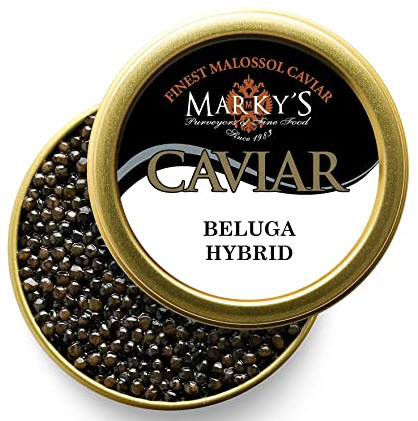Caviar
Only salt-cured roe from fish of the order Acipenseriformes is considered true caviar. All the extant fish species in this order belong to either the family Acipenseridae (sturgeons) or the family Polyodontidae (paddlefish).
In the trade, you can find salt-cured roe from a wide range of other fish, but that is not true caviar, although it might be labelled caviar in countries that are not very strict about upholding the distinction, or that have a tradition of calling all type of fish-roe intended for human consumption caviar. It is therefore important to do a bit of research before you buy, if it is important for you to get true Acipenseriformes caviar. Salmon roe, lumpfish roe, trout roe, and carp roe are all examples commercially available forms of roe that are sometimes referred to as caviar.
Some of the more devoted caviar fans have their own even stricter definitions of caviar, and will only consider fish roe caviar if it is salt-cured roe from wild sturgeons caught in the Caspian Sea or Black Sea.
Alternative spelling

In English, caviar can also be spelled caviare.
Famous caviar varieties
Beluga caviar
Beluga caviar is famous for its big eggs, which can be as large as a pea, and range in colour from blackish to silver-gray and pearly white. The pearly white beluga caviar is even more expensive than normal beluga caviar, and can only be found in older sturgeons (“almas”).
Beluga caviar is the roe of the beluga sturgeon (Huso huso). This species is chiefly found in the Caspian Sea, but also in the Black Sea basin and the Adriatic Sea.
Sterlet caviar
Sterlet caviar is comprised of small fish eggs of a golden shade. Historically, sterlet caviar was associated with royalty due to the golden colour, and sterlet caviar was a favourite of the Russian tsar family, the Habsburg monarchs and the Shahs of Persia and Iran.
Ossetra caviar
Genuine Ossetra caviar is brown to golden-yellow, and the eggs are of medium size. Ossetra caviar which is golden-yellow fetch a higher price.
Sevruga caviar
Sevruga caviar is comprised of small eggs of pearlescent grey colour and is normally less costly than Beluga and Ossetra. It comes from the Sevruga sturgeon; a species of sturgeon that is relatively small in size.
Siberian caviar
Siberian caviar is black and the eggs are small. Most of the commercially available versions of Siberian caviar taste brinier than Beluga, Sterlet and Sevruga caviar.
Kaluga hybrid caviar
China is the main producer of Kaluga hybrid caviar. It comes in several colours and hues, including dark grey and a pale goldish-green.

Fresh vs. pasteurized
Cavaiar can be pasteurized or non-pasteurized. The non-pasteurized version is known as fresh caviar, and is typically more expensive than pasteurized caviar. Non-pasteurized caviar must be kept cold to avoid spoilage, even if the package is unopened.
Pasteurization does impact the texture a bit, which is why some caviar connoisseurs opt for fresh caviar despite the price difference.
Caviar production
Today, China is the largest producer of caviar and roughly 60% of the world´s commercially available caviar comes from China. Other examples of notable producers are the United States (especially California), Canada, Uruguay, Israel, the United Kingdom, Italy, Iran, and Saudi Arabia.
The traditional way of extracting caviar from the fish is to stun her and cut out her ovaries. Today, some producers instead use the stripping technique, where only a small incision is made along the urogenital muscle. In captive-bred fish, a ultrasound can be utilized to select the optimal date for the procedure.
To make caviar, newly extracted fish roe is passed through a sieve to get rid of the membrane, before the eggs are rinsed. The eggs are then salt-cured to preserve them.
As noted above, some caviar products are pasteurized.
Caviar price
Genuine caviar is expensive. The exact price will vary depending on the type of caviar, the country of origin and the brand of the caviar. Beluga caviar will, as an example, cost about USD150 and up.
The exact price of caviar is dependent on the exchange rates on the foreign exchange market. The price in your country will vary depending on the value of your local currency, the USD and the value of the currency in the country of origin. The currency value is set by the trade on the forex market. Banks, nations, financial institutions, international companies and retail investors all trade on the forex market. It is this trade that sets to exchange rate.
According to DayTrading.com, retail forex trading through a retail currency trading platform such as eToro, Forex.com, or AvaTrade has an extremely limited effect on currency prices. The impact of transactions made by large banks and financial institutions is an order of magnitude more significant in deciding the currency exchange rates on the market.
Nutrient profile
Caviar is is rich in salt, zinc and cholesterol, and one spoonful is enough to provide the average adult with their daily requirement of B12.
Caviar does not contain fibres and is extremely low in carbohydrates.
You can expect one tablespoon (16 grams) of caviar to contain around 40 kcal. It will also provide you with circa 4 grams of protein and less than 3 grams of fat.
Pressed caviar
Pressed caviar is typically made from broken or unusually fragile fish roe.
Sometimes pressed caviar products to include roe from more than one species of fish.
